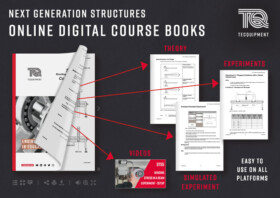Structures Course Books
Enhancing students’ learning and understanding of basic structural principles focusing on beams, bridges and cantilevers, these course books provide real life examples and theories and run through the experimental set-up, procedures, and analysis.

What are the Structures Course Books?
TecQuipment’s structures course books are a collection of free resources available for students of mechanical, civil, and structural engineering to use in laboratory sessions when learning about structures.
For each of TecQuipment’s 21 Next Generation Structures Range experiments there is a dedicated course book that goes into detail about what can be gained from performing experiments, how this translates to the real world and how this can be used by students in their future careers. We also have a designated glossary of terms, theories used and a step by step of experiment set-up, procedure, aims and analysis, along with useful textbooks.
This tool provides all the resources you need in one place to teach your mechanical, civil, and structural engineering students about structures.
How does it work?
- The resource is provided digitally where you can then download your copy and either print/or digitally distribute to your students.
- Each experiment has its own course book, so if you have purchased multiple experiments from us, you can gain access to the corresponding course books.
- To obtain this free product course book containing, theory and experiments only for student usage please email customer.care@tecquipment.com and state the product code and name in the email.
Benefits
This is a complementary free resource to go with the physical experiments you have purchased, and gives you access to all materials related to that experiment in one place which saves you time collating materials for your students.
Ancillary

Structures Course Books
Enhancing students’ learning and understanding of basic structural principles focusing on beams, bridges and cantilevers, these free course books provide real life examples and theories and run through the experimental set-up, procedures, and analysis.
